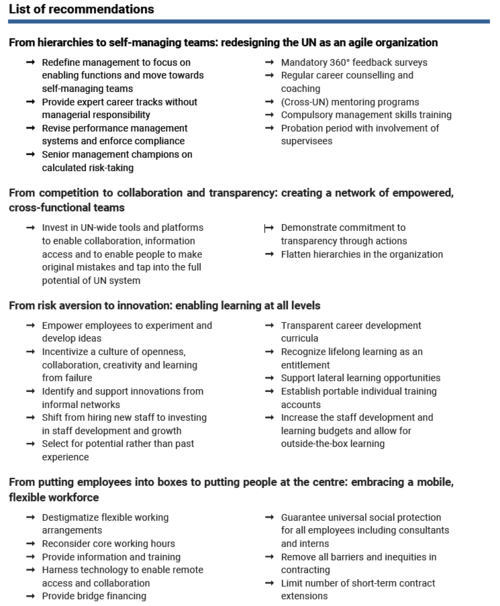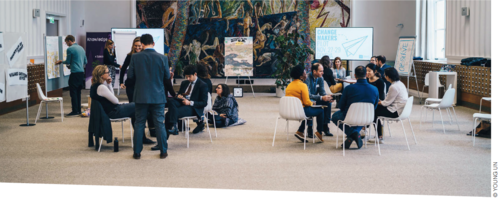What does the Next UN look like and how do we get there? The article shares findings of a study by Young UN on how we can navigate from Today’s UN – where too often bureaucracy impedes the UN’s ability to deliver on its purpose – to Next UN, an empowered organization that establishes, upholds and defends essential values and lives by them.
How prepared is the UN for future trends and changes in ways of working? Does your organization have a culture of innovation and risk-taking? Do you have sufficient autonomy and flexibility, and opportunities for learning and career development?
Young UN, a network of more than 1,600 changemakers across the UN system set out to answer these questions and more in its recent report “Navigating to the Next UN – a journey full of potential” (http://tinyurl.com/yun-fow). This article highlights some of the study’s main findings and recommendations and suggests what the future of work could look like at the UN.
Getting to know the terrain
The future of work has already started. Global trends are reshaping working environments, ways of working and people’s expectations of employers.
Upon the request of the UN Chief Executives Board High-Level Committee on Management (HLCM), Young UN prepared a study on the future of work at the UN, primarily based upon a survey that gathered the views of 859 respondents working in more than 30 UN entities in 90+ countries.
The study’s findings indicate that the UN system shares with many other large organizations across sectors the struggle to change to remain relevant and retain talent in today’s world. Traditional organizational structures are increasingly seen as incompatible with new ways of working, leading many organizations to reinvent themselves to become more agile and innovative. Pioneering organizations across sectors are reducing hierarchies, silos, and bureaucracy, while nurturing an environment where highly collaborative, empowered, and cross-functional teams can thrive. As the future of work requires the ability to change and adapt, continuous learning is becoming a standard that equally benefits employees and their organizations. Employees’ expectations are shifting too, with purpose and flexible working being increasingly prioritised.
A journey full of potential
The UN is, on paper, unmatched in its compelling purpose. It has the potential to be the most impactful organization and the most attractive employer in the world.
The findings of our survey suggest, however, that the UN is falling short. Why? Today’s UN does not make the most of its people and their potential. Bottlenecks identified in the study include:
- Lack of transparency and engagement. People want to shape decisions in their organization but only about a fifth feel they have a voice and opportunities to do so. Less than a quarter agree that their organization is transparent and openly shares information with employees.
- Insufficient learning and career development. In the next five years, the majority of respondents are interested in transitioning between UN entities or duty stations, or in re- and upskilling. Yet less than a third of respondents feel their organization helps them to acquire the skills and knowledge needed to get better at what they do, and only a quarter feel their organization supports their career development. Under 20% of respondents feel their organization enables them to reach their full potential.
- Limited culture of innovation. Only 14% think that their organization has a culture of innovation and risk-taking. The majority do not feel encouraged to experiment with new and better ways of doing things due to lack of support from senior management or direct supervisors and/or lack of dedicated time within working hours.
- Limited emphasis on flexibility and collaboration. More than 80% are interested in collaboration opportunities outside their core team and flexible working arrangements are highly appealing to respondents. Such opportunities are, however, limited and/or not supported by supervisors.
- Insufficient employment predictability. Although most respondents would like to stay in the UN system given the opportunity, more than two thirds feel concerned that they will have to leave within the next two years because their contract expires. This proportion rises to over 90% for consultants, service contract holders and temporary appointments. The majority (75%) of respondents have a planning horizon of one year or less and two thirds are actively seeking job opportunities, mainly within the UN system.
These findings point to a UN that is not sufficiently prepared for the future of work. Almost nine out of ten respondents feel their organization is not at all or only somewhat prepared for the future of work.
If these issues remain unaddressed, the UN will likely increasingly struggle to retain talent: lack of career development opportunities, poor management practices, underutilization of skills and lack of employment predictability were the most common reasons why respondents would leave the organization.
So what should Next UN look like and how do we get there? Based on the survey findings, the report outlines four shifts in mindsets, structures and practices that are needed to make the UN fit for the future of work and give its people the space, choices and security to grow:
- From hierarchies to self-managing teams: redesigning the UN as an agile organizationSelf-management enables individuals to perform management tasks freely and autonomously within a given, flexible framework but without a mechanistic hierarchy. The UN can work towards this by moving from hierarchies to networks and reimagining the role of managers to focus on enabling functions, including coaching. Self-management models could be piloted and then scaled up, if successful.
- From competition to collaboration and transparency: creating a network of empowered, cross-functional teamsThe UN has the ingredients to become the agile organization needed to achieve the Sustainable Development Goal (SDGs). But better systems to enable collaboration and to distribute authority and decision-making are needed. This entails a shift from static job descriptions, grades and contract types defining people’s roles and place in the organization, to a project-based approach in which people can contribute where their skills are needed, teams gather and disperse according to needs, sourced by a unified UN system talent pool.
- From risk aversion to innovation: enabling learning at all levelsMainstreaming innovation across the UN requires shifts on many levels, including time and space to experiment and develop ideas, creating incentives for innovation, openness and creativity, and establishing a supporting structure that enables innovation to happen across all functions, departments and duty stations.
- From putting employees into boxes to putting people at the centre: embracing a mobile, flexible workforceThe UN needs to act on its principles when it comes to basic employment security and social protection. The organization should offer more transparent and predictable career paths that allow for a longer planning horizon for employees, free from fear about their personal and professional future.
Concrete recommendations to support each of these shifts are summarised in box 1. The report also includes good practice examples, crowdsourced across the UN system and beyond.

Time to get going
Adapting to trends in the future of work may sound like an ambitious task, particularly in the UN context. But as our study highlights, organizations that have much in common with the UN are successfully engaging in such journeys. In fact, the study itself is a good example of how new ways of working can be implemented at the UN. Young UN members were invited to join a dedicated project team that was self-organised, primarily collaborating through online platforms, shared documents and video calls. The distribution of roles and tasks was fluid and based on availability, ability, and interest of team members. Far from adding hurdles, this process enabled the timely delivery of a study presenting fresh ideas and enriched by the diversity of perspectives of its contributors.
With innovative initiatives sprouting, from innovation labs across the system to #NewWork and The Knowledge and Learning Commons to name but a few, momentum is gathering to renew the UN from within. Young UN is actively participating in the CEB task force on the future of the UN system workforce and continuing to drive change locally. In November, for example, the network piloted the Changemakers of the UN Programme. This programme was the first of its kind in the UN system and equipped changemakers in Geneva with the perspectives, skills and tools to effectively drive change in the UN and beyond.
All of us have a role to play in shaping the Next UN. If you’d like to join us in this journey, we’d love to hear from you at young.un.info@gmail.com.


